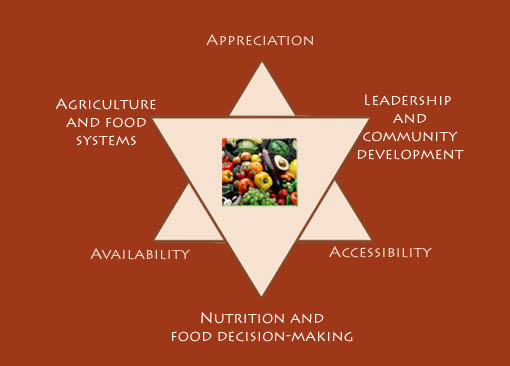Goals of the Food Decision-Making Program:

The Food Decision-making Program’s mission is to help people think differently about food and eating and the interrelationships within the food system. The food decision-making program aims to build family and community capacity to identify and implement effective change strategies. The figure above illustrates the trans-disciplinary approach that drives many of our collaborations and initiatives. The long term goal of the program is to improve the health and well-being of children/youth and their families through trandisciplinary research, co-learning, and co-creation.
Availability, access and appreciation lie at the center of many community nutrition issues. Availability refers to sufficient quantities of appropriate and necessary food in the community food system. Accessibility refers to a family’s ability to acquire this available food for their family. Appreciation refers to liking a given food and at the same time recognizing the benefits of choosing particular foods to their own health and well-being and to their community’s economic and environmental well-being. For example, appreciating local foods may involve recognition of the benefits to local food producers and to the economy by keeping the food dollar within their community. Maximizing availability, accessibility and appreciation may have important benefits to the individual, family and community. The individual may improve health, the family may adopt healthier eating practices, and the community may gain economic and ecological benefits.
Long-term goals for the food decision-making program have three key foci: food systems and health, leadership development, and engaged methodology. The food decision-making program follows an ecosystems approach which stresses the importance of the interactions between the community food system and the family food subsystem. In addition, the ecosystems approach illustrates the interrelationships with other natural and social systems within the micro and macroenvironments.
- Food decision-making- The food decision-making program aims to strengthen the connections among sustainable food systems, health and well-being through a greater understanding of food decision-making and community collaborations. The sustainable food system can directly affect health and well-being, or the influence can be mediated by family food decision-making. Alternatively, health status can influence family food decision-making and the larger food system.
- Leadership development- To build family and community capacity, the food decision-making program supports leadership development projects that connect graduate, and undergraduate students; community-based educators, leaders, and decision-makers; food system stakeholders; and researchers for mutual learning. By supporting existing leadership potential in the community, we are able to maximize potential impact and maintain values of collaboration and integration.
- Engaged methodology- The food decision-making program uses collaborative grounded theory methodology that focuses upon conducting research with people rather than on people and increasing the validity and value of research. As described in Gillespie and Gillespie, 2006, this methodology incorporates local wisdom and builds community leadership capacity through engaging community-based professionals and para-professionals in the research process. In addition to building capacity for participation and leadership in research, education and action, this approach can increase the validity and value of the research and facilitate its application in community led programs.
